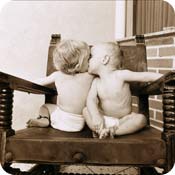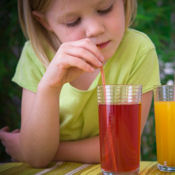 Cloth diapers have come a long way in recent years. Pins and plastic pants are quickly becoming a thing of the past, making way for new all-in-one versions that rival the convenience of disposables. Virtual stores selling cloth diapers abound on the Internet, offering a plethora of varieties. Here's a basic tutorial of the many types of cloth diapers on the market today:
Cloth diapers have come a long way in recent years. Pins and plastic pants are quickly becoming a thing of the past, making way for new all-in-one versions that rival the convenience of disposables. Virtual stores selling cloth diapers abound on the Internet, offering a plethora of varieties. Here's a basic tutorial of the many types of cloth diapers on the market today:
- Flat. One giant square of a single layer of fabric. You fold it to size, and fasten it with pins or other fasteners, then cover with a diaper cover. These are probably what your grandparents used.
- Pre-fold. Multiple layers of fabric in a rectangular shape, with a thicker panel running lengthwise down the diaper. You fasten it with pins or other fasteners, then cover with a diaper cover. These are probably what your parents used, if they used cloth.
- Contoured. The same as a pre-fold, but hourglass shaped rather than rectangular. You fasten it with pins or other fasteners, then cover with a diaper cover.
- Fitted. Shaped just like a disposable diaper, with elasticized legs. You fasten it with built-in, adjustable Velcro or snaps at the waist, then cover with a diaper cover.
- Pinnable. Shaped just like a disposable diaper, with elasticized legs but without adjustable Velcro or snaps at the waist. You fasten it with pins or other fastener, then cover with a diaper cover.
- All-In-One. Shaped just like a disposable diaper, with elasticized legs and adjustable Velcro or snaps at the waist. No cover is needed as a waterproof layer is sewn right in to the diaper.
Cloth diapers, especially the fitted and all-in-one varieties, are a big investment up front. But even with a top-notch diaper layette, the savings still adds up, especially when you consider that well-made cloth diapers will last through multiple children.
Cloth Diaper Material: Cotton or Hemp?
If you've been shopping for cloth diapers, you'll probably notice many online companies offering diapers made of hemp fabric. Hemp products are more environmentally friendly than cotton, they are more biodegradable, and although hemp is a relative of marijuana, hemp is virtually free of THC, the psychoactive substance in marijuana. Here are some reasons hemp diapers outperform their cotton competition:
- Hemp fabric is three times stronger than cotton fabric.
- Hemp fabric is more absorbent than cotton fabric.
- Hemp has natural antifungal and antibacterial properties, and is mildew resistant.
- Hemp can be grown pesticide-free, while cotton is one of the most environmentally destructive crops, accounting for 25% of world pesticide use.
The United States Declaration of Independence was written on paper made of hemp. In fact humans have used hemp products for the past ten thousand years!
If cotton is your fabric of choice, consider organic and unbleached varieties. While cotton (especially organic cotton) is soft and natural, the bleaching process used to produce white cotton fabric is not. Chlorine bleach releases a chemical called dioxin into the environment. Dioxin is a recognized public health threat, and there is no safe level of exposure. Although fabric bleaching is but one of many industrial sources of dioxin, buying unbleached cotton diapers is at least a small step in the right direction. It also lets manufacturers know where you stand.
And besides being responsible, you'll also get a superior product. Unbleached cotton has never been through the harsh bleaching process, so the fibers are in their natural state. The intact fibers make for softer, longer-lasting diapers. Another benefit of unbleached diapers is that they hide stains better, due to their off-white color. To get out tough visible stains, air dry diapers outside in direct sunlight-mother nature's bleach!
Diaper Covers: Wool is Cool
When using cloth diapers, a cover is necessary to prevent the wet diaper from soaking through baby's clothes. Years ago, plastic was the material of choice for diaper covers. But plastic, polyurethane, nylon, and other synthetic materials, while waterproof, restrict air flow to baby's sensitive skin, and may lead to rashes. They also tend to break down over time, especially when subjected to the rigors of repeated washings. There is an alternative to these materials that's durable, inexpensive, and environmentally friendly. Diaper covers made of wool work amazingly well due to four qualities:
- Wool contains lanolin, a natural water repellant. Lanolin is what keeps sheep dry in the rain, and if you use wool covers, it keeps baby's clothes dry as well.
- Lanolin helps make the wool resistant to bacteria, so wool covers only need to be washed about once every two weeks (unless they get poop on them). Rotate covers and air them out between uses to allow urine odors to dissipate.
- Wool can hold up to 35 percent of its weight in water vapor while still remaining dry to the touch.
- Because wool is porous, it allows for the circulation of air, which helps maintain a cool temperature within the diaper, helping to prevent diaper rash.
To improve the water-resistant abilities of your wool covers, add a teaspoon of lanolin to a cup of steaming hot water. When it dissolves, pour it into a sink full of lukewarm water, and add your wool covers. Work the lanolin into the fibers of the covers and let them air dry.
How to Wash Cloth Diapers
The reason most people give for not using cloth is that they don't have the time for all the washing. If you buy three dozen cloth diapers, you only have to wash every 2-3 days, about twice a week. You don't need any special detergent or supplies to wash cloth diapers--just a washing machine, your detergent, and a diaper pail. Here are the basic steps of cloth diaper washing:
- Wash and dry new cloth diapers a few times before using them. The material will fluff up and become more absorbent after each washing.
- To keep down odors in the diaper pail, sprinkle in a little baking soda each time you toss in a diaper.
- When changing a wet diaper, or poopy diaper from an exclusively-breastfed infant, throw it right into the diaper pail. Your washing machine will handle it.
- When changing a poopy diaper from an infant on formula or solids, shake out the poop into the toilet, and then toss the diaper into the pail. (Do not throw poop into the trash, as it contaminates groundwater when it goes to a landfill. Flushing it will ensure that it's properly treated at the sewage plant.)
- When your diaper pail is full, dump the diapers in the washing machine, and do a quick cycle on cold, with no detergent. Use the highest water setting (i.e. full load). To give the diapers plenty of room to get clean, never wash more than 24 diapers in each load.
- Add one-fourth of the recommended amount of detergent (not soap powder) and wash a second time in hot water.
- Dry in the dryer or hang dry.
Cloth Diapers On-The-Go
A common misconception about cloth diapers is that they're too inconvenient to use when you're out on the town with baby. But as long as your diaper bag is stocked with the essentials, the convenience of cloth diapers can rival that of disposables. Here's what you need for a well-stocked diaper bag:
- Diapers. You'll need about one diaper for every few hours you plan to be away from home. Any style will do, but many parents who use less-expensive pre-folds at home choose to use fitted diapers or all-in-ones when they're away from home.
- Pins or other fasteners, if your diapers require them. To get diaper pins to slide easily through even the thickest diaper, run the tip through a bar of soap. It will glide right in the diaper without fuss.
- Diaper cover. Just in case of a blowout, it's a good idea to pack an extra one.
- Wipes. Cloth wipes are truly the best. Not only can they be reused, but they can be tossed right into the dirty diaper and not thrown away separately.
- Wipes solution. You can either pre-moisten your cloth wipes, or carry a well-sealed squirt or spray bottle in the bag. The latter eliminates the risk of forgetting wet wipes are in there and allowing them to mildew.
- Wet Bag. You can either use a bag designed for holding soiled diapers (made of waterproof fabric), or just reuse plastic grocery bags. Just make sure you keep them out of baby's reach!
- Changing pad. Anything will do. You can use a blanket or an official padded changing pad. Just make sure it's large enough for baby.
Cloth Wipes: Do It Yourself!
When you're using cloth diapers, cloth wipes just make sense. Since they can be thrown right into the dirty diaper and washed right along with the diapers, they are more convenient than disposable wipes that have to be tossed separately. Cloth wipes can also be virtually free, if you make them yourself from stuff you probably have lying around your house. Here's how to make your own wipes.
- Gather together your materials. Wipes can be made out of old, thin towels or old flannel baby blankets or shirts. To make them you'll need scissors, a ruler, thread, and a sewing machine.
- For each wipe, cut two squares of fabric, 8.25 inches by 8.25 inches. The best wipes will have a flannel side and a terry cloth side.
- Place the squares' good sides together.
- Stitch around the wipe, about .25 inches from the edge, almost all the way around the square, leaving enough of an opening to turn the good sides out.
- Turn the good sides out, and push out the corners with a pencil or other long slender object.
- Stitch all the way around the wipe again, as close to the edge as possible, closing the opening and giving the wipe a finished look.
To make your own wipe solution, mix together 2 cups water, 1/4 cup aloe vera gel, and a few drops of tea tree oil. Shake well. It will stay fresh in the container for about one week. Instead of pre-moistening your wipes to carry with you while you're out, simply throw a well-sealed squirt bottle filled with water into the diaper bag, and squeeze it onto the wipe right before using.
When it comes to your baby's well-being, your wallet and protecting the environment for your little one's future, cloth diapers defeat the competition.
|
 Cloth diapers have come a long way in recent years. Pins and plastic pants are quickly becoming a thing of the past, making way for new all-in-one versions that rival the convenience of disposables. Virtual stores selling cloth diapers abound on the Internet, offering a plethora of varieties. Here's a basic tutorial of the many types of cloth diapers on the market today:
Cloth diapers have come a long way in recent years. Pins and plastic pants are quickly becoming a thing of the past, making way for new all-in-one versions that rival the convenience of disposables. Virtual stores selling cloth diapers abound on the Internet, offering a plethora of varieties. Here's a basic tutorial of the many types of cloth diapers on the market today:






Member Comments